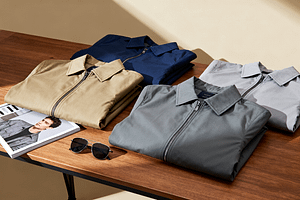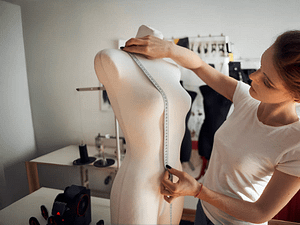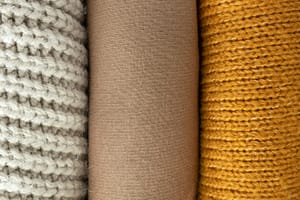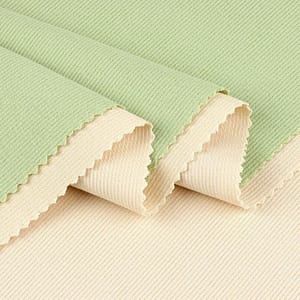Introduction
Velour fabrics are soft, plush, and irresistibly cozy, long capturing the imagination of both fashion designers and everyday wearers. Known for their rich texture and subtle sheen, they bring together the best of two worlds: the everyday comfort of casual wear and the elegance often reserved for luxury textiles. Unlike many fabrics that are either purely practical or strictly ornamental, velour sits in the middle—warm, versatile, and stylish. It’s no wonder that velour has continued to cycle through trends over the decades, from royal-inspired origins to tracksuits and beyond.
What is Velour?
Velour is a plush, knitted fabric characterized by its soft pile and smooth finish. It is often confused with velvet, but while both fabrics share a luxurious look, their construction is different. Velvet is traditionally woven, giving it a more rigid, formal feel, whereas velour is knitted, making it naturally stretchier and more comfortable to wear.
The surface of velour is created by looping fibers and then cutting them to form a dense, even pile. This gives the fabric its signature texture: soft, slightly glossy, and tactile. Traditionally, velour was made from cotton, but modern variations frequently use polyester or blended fibers, which enhance durability and make it easier to care for.
This unique combination of plushness, stretch, and resilience makes velour a standout choice for clothing, upholstery, and accessories—offering the luxury of velvet with the comfort of knitwear.

The History of Velour
Velour’s story begins as an accessible alternative to velvet, a fabric historically associated with wealth and royalty. While velvet was costly to produce due to its woven structure and silk content, velour offered a more affordable option thanks to its knitted base and use of cotton. This democratized the luxurious look, making plush textures available to the broader public.
By the mid-20th century, velour had secured its place in popular culture. It became a favored fabric for theater curtains and stage costumes, where its rich texture and slight shimmer enhanced dramatic effect. In the 1970s, velour stepped into everyday fashion with the rise of tracksuits and leisurewear. Its combination of stretch and softness made it the ideal choice for comfort-driven clothing.
The early 2000s saw another velour boom, as Y2K fashion embraced the fabric in colorful, logo-studded tracksuits and loungewear. Today, velour is experiencing yet another revival, balancing nostalgia with modern design sensibilities—appearing in both high fashion and casual wear.
The Unique Qualities of Velour
What makes velour so beloved is not just its appearance, but also its distinctive qualities that set it apart from other fabrics.
- Softness and Plush Texture
Velour’s dense pile creates a touchable, velvety surface that feels indulgent against the skin. This softness makes it especially popular for loungewear, upholstery, and performance costumes. - Stretch and Comfort
Because velour is knitted rather than woven, it naturally has more flexibility. This built-in stretch allows for freedom of movement, making it ideal for garments that need to balance style and ease of wear. - Warmth and Coziness
The fabric’s thickness and pile help retain warmth, making it a cozy choice for cooler seasons. Its insulating properties add to its reputation as a comfort fabric. - Elegant Sheen
One of velour’s most eye-catching traits is its subtle shine. The way light reflects off its short pile gives it a rich, luxurious look without being overly flashy.
Together, these features explain why velour continues to appeal across different industries and style movements—it delivers tactile pleasure, functional comfort, and visual elegance all at once.

Velour in Fashion
Velour has left an unmistakable mark on the fashion world, evolving through different eras while retaining its signature blend of comfort and luxury.
- Sportswear and Loungewear
Perhaps most famously, velour became synonymous with leisurewear in the 1970s. Tracksuits made from the fabric combined sporty practicality with a glamorous twist, paving the way for athleisure as we know it today. Its soft stretch made it perfect for relaxed silhouettes, while its sheen added an elevated touch. - High Fashion Reinterpretations
In recent years, high-end designers have revisited velour, transforming it from a nostalgic staple into a fabric of sophistication. Runway collections have featured velour dresses, tailored separates, and statement pieces, proving its versatility extends far beyond casual wear. - Accessories and Details
Beyond clothing, velour has also been embraced in smaller fashion details—think plush handbags, hats, and even footwear. Its rich texture makes accessories pop while adding a sense of softness and depth. - Modern Revival
The early 2000s gave velour tracksuits a pop-culture moment, cementing their status in fashion history. Today, a wave of Y2K nostalgia has brought velour back into the spotlight. Contemporary takes often blend classic silhouettes with updated colors and cuts, appealing to both retro enthusiasts and new audiences.

Care and Maintenance of Velour
While velour is durable compared to many luxury fabrics, it requires proper care to maintain its plush texture and vibrant appearance. With the right attention, velour garments and furnishings can stay soft and stylish for years.
- Washing Tips
Most velour items should be washed on a gentle cycle with cold water, ideally inside out to protect the pile. Using a mild detergent helps prevent fading and keeps the fabric’s softness intact. Hand washing is another safe option, especially for delicate pieces. - Drying and Storage
Velour should never be subjected to high heat, as it can damage the fibers and flatten the pile. Air-drying is recommended, either laid flat or hung in a way that avoids stretching. When storing, keep velour items in a cool, dry place to avoid moisture damage. - Maintaining Softness and Color
To keep the fabric plush, avoid ironing directly on the surface. Instead, use a steamer or press lightly with a cloth barrier. For clothing, brushing the surface gently with a soft fabric brush can help restore the pile and keep it looking fresh. - Longevity Compared to Other Fabrics
Thanks to its knitted structure and blend of fibers, velour can outlast many other plush fabrics when cared for correctly. Unlike velvet, which is more delicate and prone to crushing, velour’s resilience makes it practical for everyday wear and home use.

Conclusion
Velour is more than just a fabric—it’s a symbol of how comfort and luxury can coexist. From its origins as a more accessible version of velvet to its iconic role in fashion and popular culture, velour has proven its staying power. Its softness, stretch, and distinctive sheen make it a favorite for designers and wearers alike, whether in relaxed loungewear, bold runway pieces, or timeless everyday garments.
What truly sets velour apart is its versatility. It can dress up casual outfits, bring glamour to sportswear, and offer coziness without compromising style. Few fabrics manage to balance functionality with indulgence as seamlessly as velour.






